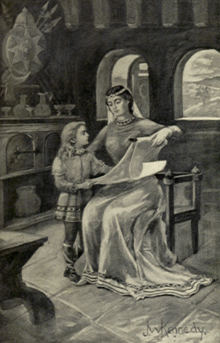Osburh
| Osburh | |
|---|---|
 Queen Osburh reading to her son Alfred, illustration in M. F. Lansing, Barbarion & Noble, 1911 | |
| Queen consort of Wessex | |
| Tenure | c. 839 - c. 854 |
| Spouse | Æthelwulf, King of Wessex |
| Issue |
Æthelstan of Wessex Æthelswith, Queen of Mercia Æthelbald, King of Wessex Æthelbert, King of Wessex Æthelred, King of Wessex Alfred, King of Wessex |
| House | House of Wessex (by marriage) |
| Father | Oslac |
Osburh or Osburga was the first wife of King Æthelwulf of Wessex and mother of Alfred the Great. Alfred's biographer, Asser, described her as "a most religious woman, noble in character and noble by birth".[1]
Osburh's existence is known only from Asser's Life of King Alfred. She is not named as witness to any charters, nor is her death reported in the Anglo-Saxon Chronicle. So far as is known, she was the mother of all Æthelwulf's children, his five sons Æthelstan, Æthelbald, Æthelberht, Æthelred and Alfred the Great, and his daughter Æthelswith, wife of King Burgred of Mercia.
.jpg)
She is best known for Asser's story about a book of Saxon songs which she showed to Alfred and his brothers, offering to give the book to whoever could first memorise it, a challenge which Alfred took up and won. This exhibits the interest of high status ninth-century women in books, and their role in educating their children.[2]
Osburh was the daughter of Oslac (who is also only known from Asser's Life), King Æthelwulf's pincerna (butler), an important figure in the royal court and household.[3] Oslac is described as a descendant of King Cerdic's Jutish nephews, Stuf and Wihtgar, who conquered the Isle of Wight.[4] and, by this, is also ascribed Geatish/Gothic ancestry.
Issue
| Name | Birth | Death | Notes |
|---|---|---|---|
| Æthelstan | 851–855 | ||
| Æthelswith | 888 | Married, Burgred of Mercia; no issue | |
| Æthelbald | 860 | Married, Judith; annulled | |
| Æthelbert | 865 | ||
| Æthelred | 871 | Had issue | |
| Alfred | 849 | 26 October 899 | Married 868, Ealhswith; had issue |
See also
Notes
- ↑ Simon Keynes and Michael Lapidge eds, Alfred the Great: Asser's Life of King Alfred and Other Contemporary Sources, London, Penguin Classics, 1983, p. 68
- ↑ Janet L. Nelson, Osburh, 2004, Oxford Online Dictionary of National Biography In Nelson's view, Osburh may have been dead by 856 or may have been repudiated.
- ↑ Keynes and Lapidge, pp. 68, 229.
- ↑ Asser states that Oslac was a Goth, but this is regarded by historians as an error as Stuf and Wightgar were Jutes. Keynes and Lapidge pp. 229-30 and Frank Stenton, Anglo-Saxon England, Oxford, Oxford UP, 3rd edition 1971, p. 23-4
References
- Asser's Life of King Alfred
- Lees, Clare A. & Gillian R. Overing (eds), Double Agents: Women and Clerical Culture in Anglo-Saxon England. University of Pennsylvania Press, Philadelphia, 2001. ISBN 0-8122-3628-9